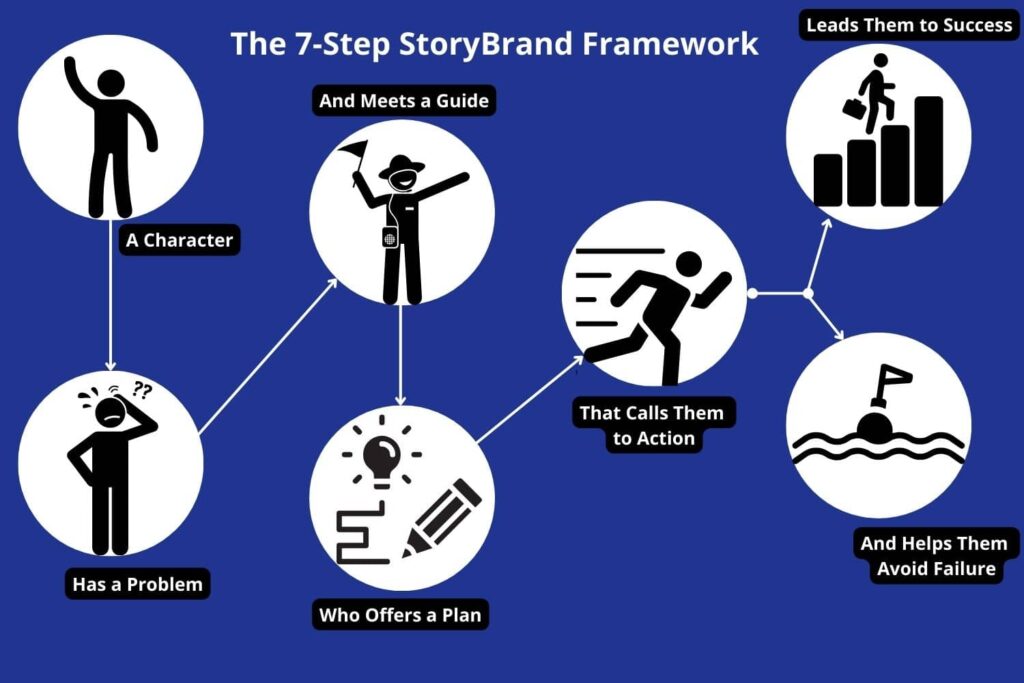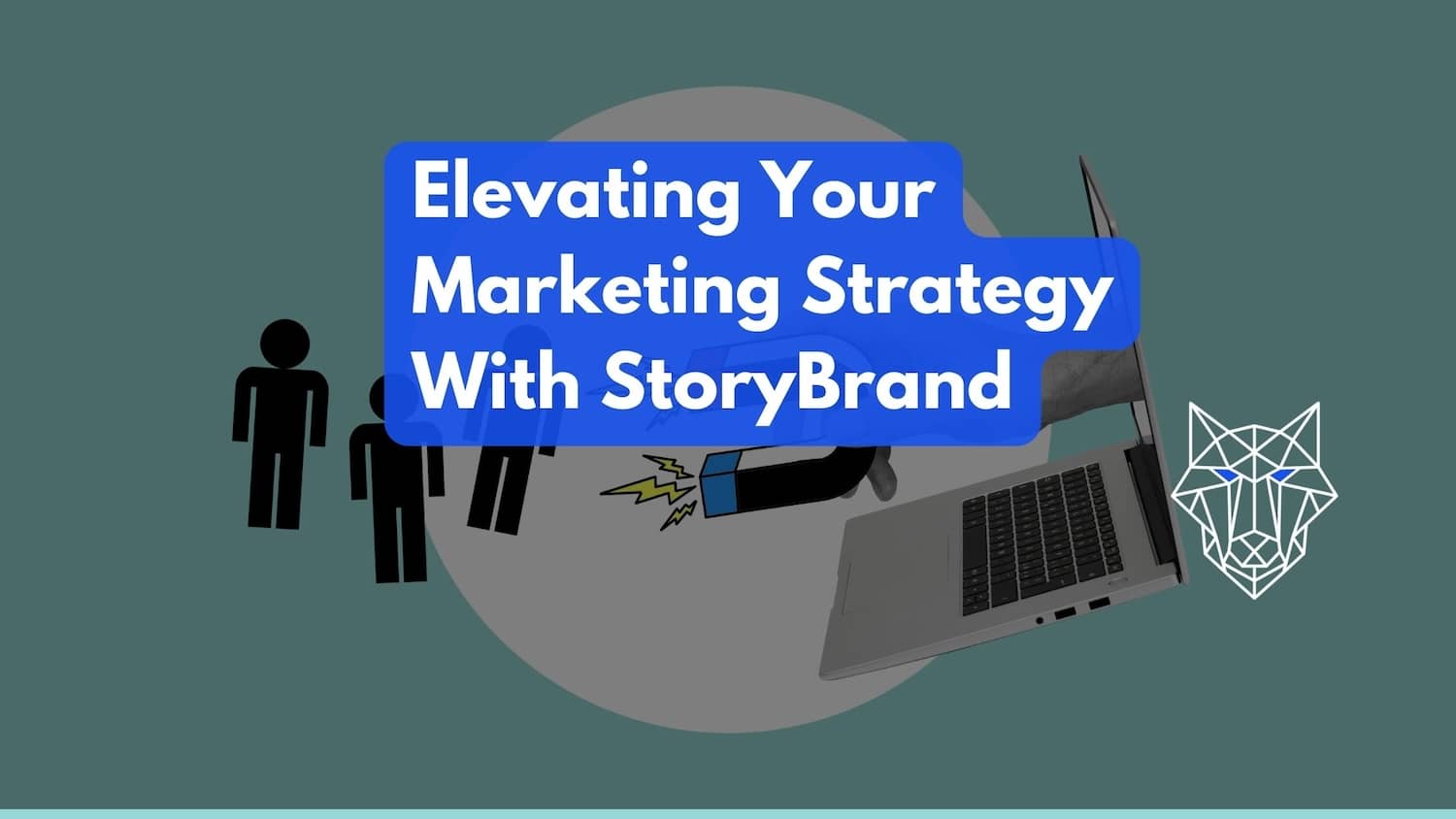In a bustling sea of brands, each clamoring to be heard, it’s easy for your business’s story to be swept away in the noise. That’s where the StoryBrand Framework steps in, offering a straightforward, narrative-driven method to ensure your voice resonates with your audience. StoryBrand is a revolutionary marketing strategy, inviting your customers into a story where they play the starring role.
In this article, we’re going to dissect a new way to communicate, illustrating how seven pivotal elements can refine and elevate how you market. Seasoned marketer or digital novice, the StoryBrand principles might just be the narrative twist your strategy needs.
What is StoryBrand Marketing?
At its core, StoryBrand is a marketing framework that helps businesses clarify their message using the elements of storytelling. The philosophy behind StoryBrand is simple yet profound: every customer is the hero of their own story, and they’re looking for a guide to help them navigate their challenges. Your business, when positioned correctly, becomes that guide.
Developed by Donald Miller in his book “Building a StoryBrand,” this approach flips traditional marketing on its head. Instead of focusing on the company’s story, it emphasizes the customer’s journey. It’s a shift from company-centric messaging to customer-centric storytelling — a strategy that not only captivates attention but also fosters loyalty and engagement.
The framework is built around a seven-part process that mirrors the classic narrative structure found in film and literature. This narrative structure is powerful because it’s how humans have been communicating and understanding the world for millennia. When businesses employ this structure, they tap into a deep-rooted mechanism that the human brain is already wired to respond to – a good story.
Why does this matter for your marketing? Because in a world brimming with options and information overload, customers are drawn to brands that they can understand quickly and that make them feel seen and understood. StoryBrand helps you to strip away the complexity and get to the heart of what your customers want, creating a message that is clear, engaging, and impossible to ignore.

The Seven Elements of StoryBrand
The “magic” of the StoryBrand Framework lies in its seven elements, each designed to help you craft a compelling narrative for your brand. Together, these elements form a roadmap for your marketing messages, ensuring they are clear, relatable, and effective. Let’s unpack these elements to see how they can transform your marketing efforts.
1) The Character
The story begins with the character—the hero of the story, who is your customer. This element involves understanding who your customer is and what they want in the context of your brand. It’s not about demographic data; it’s about getting to the heart of your customers’ aspirations and needs. If you’re a home inspection business, the character might be a first-time homebuyer!
2) The Character’s Problem
Next, every good story has conflict. For your customers, this conflict comes in the form of a problem they face. Here, we identify not just the external problem but also the internal feelings that come with it. Your marketing should address both to create a message that resonates on a deeper level.
Continuing with the above example of a home inspector, your first-time home buyer character is likely anxious about making a sound investment. Understanding this character’s desire for peace of mind and a secure purchase is crucial.
3) Become Their Guide
In this step, your brand is introduced as the guide. Customers aren’t looking for another hero; they’re overwhelmed by their challenges and are seeking a guide with a plan. Your brand’s role is to provide the wisdom, empathy, and authority they need to feel confident in following your lead.
The home inspector can position themselves as experienced professional who empathizes with the anxiety of purchasing a new home or navigating large renovations.
4) Offer Them a Plan
Naturally, a guide is only as good as the plan they offer. Consequently, this element is about presenting customers with a clear, actionable plan that leads them toward a solution. For an inspector, it could be as simple as offering a simple, three-step process that ensures a thorough evaluation of the property and minimal stress on their end.
5) Call Them to Action
Your marketing should invite customers to take a decisive step towards solving their problem. Be it making a purchase, signing up for a newsletter, or contacting your business, this call to action should be compelling and clear. For instance, a prompt to schedule an inspection to secure the integrity of the home-buying decision.
6) Help Them Avoid Failure
Equally important, this element addresses the stakes. It articulates the possible consequences of not engaging with your brand. Without creating fear, your messaging should remind customers of what’s at risk if they don’t solve their problem, reinforcing the value of your solution.
As a home inspector, your messaging could underline the potential for undiscovered issues leading to unexpected costs down the line.
7) Achieve Realistic Success
Finally, your story needs a happy ending! Your marketing should paint a picture of what success looks like for the customer after using your product or service. This vision of success is what ultimately motivates them to act and is a powerful tool for creating desire.
Implementing StoryBrand Marketing While Avoiding Pitfalls
Leveraging the StoryBrand Framework offers a transformative approach to your marketing, focusing on a narrative that places the customer at the heart of your brand’s story. To seamlessly integrate this framework and steer clear of common missteps, consider the following condensed guide:
- Focus on Clarity: Your message should be simple enough to grasp immediately. Resist the urge to include every detail about your business; instead, distill your message to its essence.
- Customer-centric Approach: Continually position your customer as the hero. Make sure every piece of content you create shows your customer why your brand matters to their story.
- Consistent Messaging Across Channels: Whether it’s social media, your website, or email marketing, your story should be uniform. A disjointed narrative can confuse your audience and dilute your message’s impact.
- Direct and Compelling CTAs: Your calls to action should lead customers toward a clear next step. Ambiguity here can result in lost opportunities, so be bold and direct.
- Demonstrate Your Track Record: Use testimonials and data to show potential customers the success they can achieve and the pitfalls they can avoid with your product or service. This builds credibility and trust.
- Balance Empathy with Authority: Connect with your audience by showing understanding of their challenges while also demonstrating your expertise. This dual approach can create a strong bond and establish your brand as a trusted guide.
- Adapt Based on Feedback: Finally, be prepared to tweak your story based on customer responses. The best narratives are those that evolve with their audience, remaining relevant and engaging over time.

Assessing the Impact of StoryBrand on Your Marketing
When implementing the StoryBrand Framework, it’s crucial to monitor a few strategic metrics that highlight the influence of your narrative-driven marketing. Here’s how to succinctly measure its success:
Key Performance Indicators (KPIs)
Conversion Rates: Observe the uptick in actions taken—from purchases to sign-ups— that are attributable to your more compelling messaging.
Customer Feedback: Direct customer insights through surveys or interactions can validate whether your story strikes a chord.
Web Engagement: Analyze user behavior changes such as time on site and bounce rate through web analytics to assess content engagement levels.
SEO and Social Metrics: Watch for improved search rankings and increased social media interaction to gauge broader audience reach and resonance.
Sales and Retention: Ultimately, sustained or increased sales and customer loyalty signify that the StoryBrand message is effectively driving business growth.
By tracking these consolidated KPIs before and after applying StoryBrand principles, you can get a clear picture of the framework’s impact and refine your approach for continued success.
Wrapping Up
When you harness the StoryBrand Framework, you do more than market—you connect. This approach can be transformative when leveraged efficiently. It turns your audience into protagonists and your brand into an essential chapter in their saga.
In short, watch the numbers, listen to the buzz, and feel the pulse of your growing business. These indicators are the applause to your brand’s narrative unfolding on the grand stage. For assistance with your marketing strategies or building your own StoryBrand, schedule a consultation with WolfPack Advising today.





